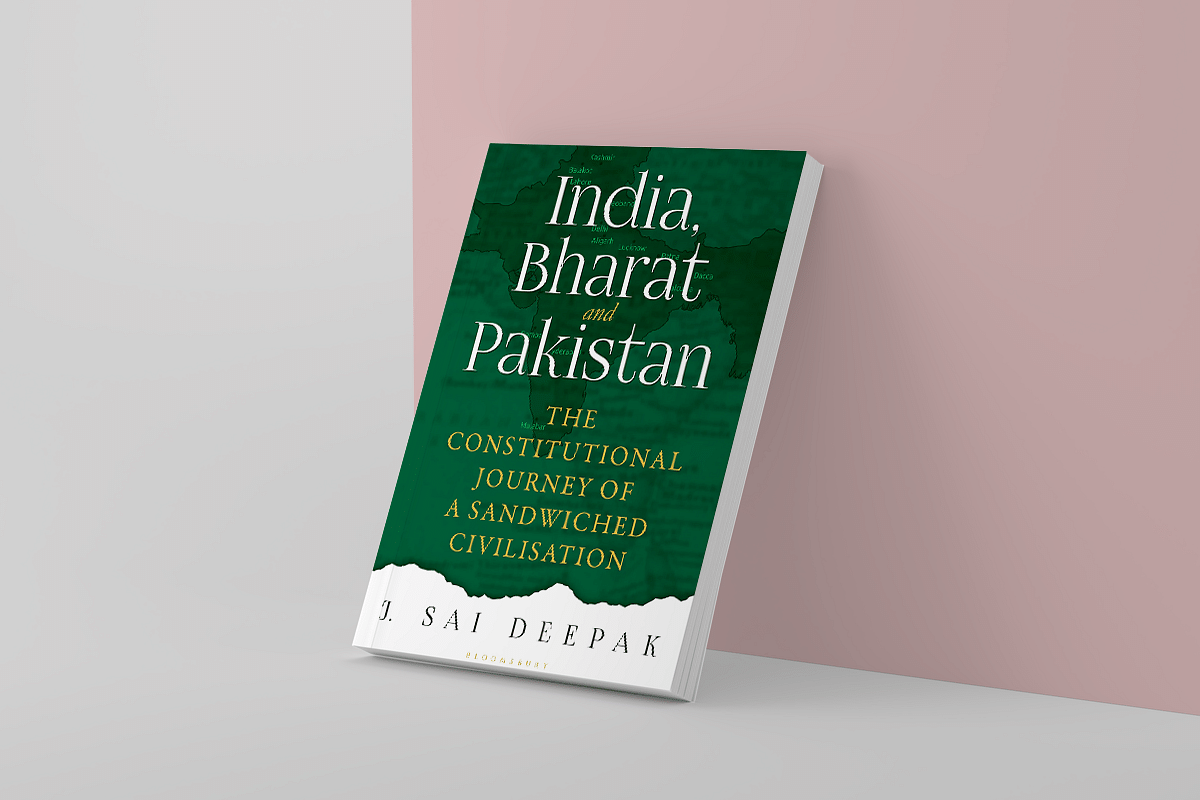Books
Book Explains The 18th Century Islamist Roots Of The Two-Nation Theory
- There are few books that provide effective counters to the bogus “secular” history of the Left-liberal dispensation.
- That's why this book is a must-read.

The cover of J Sai Deepak's book.
India, Bharat And Pakistan: The Constitutional Journey Of A Sandwiched Civilisation. J Sai Deepak. Bloomsbury. Price Rs 799. Page 616.
Hindus are fortunate to have new, young intellectuals who are not only willing to take up the challenge of countering the flawed narratives of “secular” Left-liberal history and rediscovering our civilisational heritage, but also doing something about it.
One of those energetic people is J Sai Deepak, an engineer who turned to law and who practices in the Supreme Court and Delhi High Court.
He has not only emerged as a worthy warrior fighting for Dharmic causes, but is also an effective public speaker.
Last year and this year, Sai Deepak has produced two great books in a trilogy.
The first, India That is Bharat: Coloniality, Civilisation, Constitution, shows how colonially-implanted ideas have crept into post-independence India’s politics and judiciary, thus putting our civilisational heritage to shame.
The book has been a spectacular success, having already run into several editions.
In the second book, India, Bharat and Pakistan: The Constitutional Journey of A Sandwiched Civilisation, released a few months ago, Sai Deepak takes direct aim at the origins of the two-nation theory.
It corrects a key aspect of doctored and “secular” history, which places the blame for the country’s partition on Congress politics and the rise of Mohammed Ali Jinnah alone.
Some have even gone to the extent of claiming that V D Savarkar’s Hindutva, and the Hindu Mahasabha, were as much responsible for alienating Muslims from the idea of a United India as Jinnah’s politics, thus enabling partition and the creation of Pakistan.
Sai Deepak junks this nonsense in his very first chapter, titled The Seeds of Pakistan.
He correctly traces the rise of pan-Islamic ideas to the decline of the Mughal empire with the rise of Maratha, Jat and Sikh power in the eighteenth century.
That sense of loss of a realm till then considered Dar-ul-Islam gave rise to pan-Islamic movements, including the Wahhabi movement, which started in Arabia under Muhammad ibn Abd al-Wahhab, and Shah Waliullah Dehlawi in India.
Both traced the decline of Islamic power in their regions to the failure of Islam to stick to its pristine form 14 centuries ago. They laid the roots of pan-Islamism and religious fundamentalism in the sub-continent and elsewhere.
Sai Deepak, based on strong research, traces the “successor reform Sunni movements such as Ahl-i-Hadith, Ahl-i-Quran, Deobandi, Barelvi, Nadwa, Aligarh, Tablighi and Pakistan movements” to Dehlawi’s influential work and activities for re-Islamising India.
Dehlawi clearly believed that Muslims, despite being Bharatiya in their DNA, should not integrate into the broader society they belonged to.
He asked Indian Muslims to follow the customs and traditions of the early Arab Muslims, and not the syncretic traditions they evolved in India.
From this it was just a short skip, step and jump to the idea of, first, separate electorates for Muslims under British raj, and later separate nationhood for Muslims.
Sai Deepak’s book, which is divided into nine chapters, looks at the roles played by Syed Ahmed Khan and his Aligarh movement in fanning the separatist sentiment among Muslims.
The division of Bengal in 1905 and its reunification a few years later after (largely) Hindu protests, and the shift from “Hindu-Mussalman bhai bhai” during the Khilafat movement to anti-Hindu communal violence in Malabar, Kohat, Malegaon and Gulbarga during the 1920s, are key signposts reinforcing Sai Deepak’s conviction on which mindsets were to blame for the partition.
The first chapter, which focuses on the roots of Muslim separatism in the ideas of Wahhab and Dehlawi, and chapter eight, which focuses on Gandhi, the Rowlatt Act, the Government of India Act of 1919, and the Khilafat movement, are the most important among the nine chapters.
They set the eighteenth century historical backdrop to separatist thinking that finally led to actual separation in the twentieth, and leading (post-1947) directly to the flawed secularism that our Dharmic civilisation has been forced to live with.
There are few books that provide effective counters to the bogus “secular” history of the Left-liberal dispensation.
This book is a must-read both for those who believe that Bharat is a civilisational state, and also for those who believe that India became a real nation-state because of political unification under the British, and the secular sahebs who ruled us after 1947. Both will be better informed by it.
Support Swarajya's 50 Ground Reports Project & Sponsor A Story
Every general election Swarajya does a 50 ground reports project.
Aimed only at serious readers and those who appreciate the nuances of political undercurrents, the project provides a sense of India's electoral landscape. As you know, these reports are produced after considerable investment of travel, time and effort on the ground.
This time too we've kicked off the project in style and have covered over 30 constituencies already. If you're someone who appreciates such work and have enjoyed our coverage please consider sponsoring a ground report for just Rs 2999 to Rs 19,999 - it goes a long way in helping us produce more quality reportage.
You can also back this project by becoming a subscriber for as little as Rs 999 - so do click on this links and choose a plan that suits you and back us.
Click below to contribute.
Latest